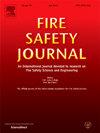薄层柴油池火沸腾行为的表征:唇部高度和水层厚度的关键作用
IF 3.4
3区 工程技术
Q2 ENGINEERING, CIVIL
引用次数: 0
摘要
泄漏在水中的多组分燃料的点火会引发复杂的沸腾现象,导致严重的燃烧事件,对附近的结构构成重大风险,并扰乱化学和加工工业的能源利用。本研究系统地研究了唇部高度和水层厚度对直径从7厘米(传导主导)到20厘米(辐射主导)的薄层柴油池火灾燃烧特性的耦合影响。实验结果表明,在稳态燃烧过程中,随着唇部高度的增加,薄层池火的质量燃烧速率逐渐降低。根据燃烧特性,将沸翻现象分为三种不同的类型:单次沸翻、多次沸翻和无沸翻。值得注意的是,在超过130°C的过热水温升高的驱动下,3厘米水层的火灾沸腾强度几乎是1厘米水层火灾的四倍。通过无因次分析,建立了一种改进的相关关系来表征不同唇部高度和水层厚度下的沸腾强度。此外,还进行了油水界面的综合不稳定性分析,以阐明控制不同沸翻行为的潜在机制。这些发现为薄层沸水火灾的燃烧行为提供了新的见解,有助于未来加强火灾风险评估和预防策略。本文章由计算机程序翻译,如有差异,请以英文原文为准。
Characterizing boilover behaviours in thin-layer diesel pool fires: The critical roles of lip height and water layer thickness
The ignition of multi-component fuels spilled on water can trigger complex boilover phenomena, leading to severe combustion events that pose significant risks to nearby structures and disrupt energy utilization in chemical and process industries. This study systematically investigates the coupled effects of lip height and water layer thickness on the combustion characteristics of thin-layer diesel pool fires, spanning diameters from 7 cm (conduction-dominated) to 20 cm (radiation-dominated). Experimental results demonstrate that the mass burning rate of thin-layer pool fires decreases progressively with increasing lip height during steady-state combustion. Based on burning characteristics, boilover phenomena are classified into three distinct regimes: single boilover, multiple boilover, and no boilover. Notably, the intensity of boilover in fires with a 3 cm water layer is nearly four times greater than in those with a 1 cm water layer, driven by elevated superheated water temperatures exceeding 130 °C. Through dimensionless analysis, a modified correlation is developed to characterize boilover intensity under varying lip heights and water layer thicknesses. Additionally, a comprehensive instability analysis at the oil/water interface is conducted to elucidate the underlying mechanisms governing different boilover behaviours. These findings offer new insights into the burning behaviour of thin-layer boilover fires, contributing to enhanced fire risk assessment and prevention strategies in the future.
求助全文
通过发布文献求助,成功后即可免费获取论文全文。
去求助
来源期刊

Fire Safety Journal
工程技术-材料科学:综合
CiteScore
5.70
自引率
9.70%
发文量
153
审稿时长
60 days
期刊介绍:
Fire Safety Journal is the leading publication dealing with all aspects of fire safety engineering. Its scope is purposefully wide, as it is deemed important to encourage papers from all sources within this multidisciplinary subject, thus providing a forum for its further development as a distinct engineering discipline. This is an essential step towards gaining a status equal to that enjoyed by the other engineering disciplines.
 求助内容:
求助内容: 应助结果提醒方式:
应助结果提醒方式:


